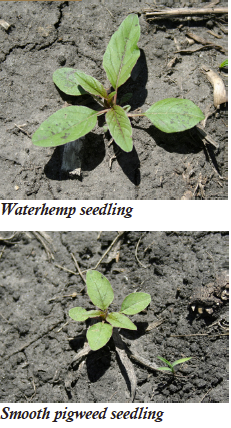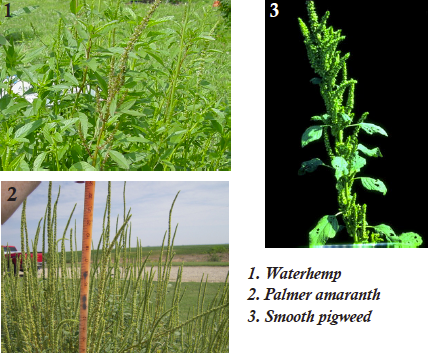|
FIGURE Waterhemp has been a significant weed issue in both corn and soybean production in the central and western cornbelt for the last 10-20 years.Waterhemp has been present in Indiana field surveys for at least the last 10 years. But recent control issues with glyphosate is moving this weed up on the radar of concern for Indiana growers. |
This publication first will provide an overview of the biological characteristics that make waterhemp difficult to manage in agronomic crops. Second, it will provide management strategies to help growers better manage this weed and slow the selection of glyphosate-resistant biotypes.
Identifying Waterhemp
Waterhemp is a member of the pigweed (or Amaranth) family, which includes other pigweed species commonly found in Indiana including redroot pigweed, smooth pigweed, and occasionally Palmer amaranth. Distinguishing the different pigweed species from one another is challenging, especially in the seedling stages.
Identifying characteristics include:
• First true leaves are generally longer than other pigweeds (Figure 1).
• Seedlings are hairless with waxy- or glossy-looking leaves.
• Waterhemp and Palmer amaranth stems are hairless, whereas other pigweeds have hairy stems.
|
FIGURE 2 |
As waterhemp matures, it becomes easier to distinguish from the other pigweeds.
Waterhemp can range from 4 inches to 12 feet tall, but generally grows to about 4 or 5 feet in most agronomic settings. Mature plant leaves are elongated and often appear waxy or glossy. Stem and leaf color tend to be shades of green, but within a population, some plants often have distinctly red stems or petioles.
Waterhemp is dioecious, meaning that the male and female flowers are on separate plants. The simplest way to distinguish between male and female plants is to rub the mature flowers between your fingers and look for the shiny, black seeds found only on female plants. Redroot and smooth pigweeds are monoecious (that is, the same plant has both male and female flowers).
Redroot and smooth pigweeds have denser, more Waterhemp plants emerge throughout the growing season, and a higherpercentage of plants emerge later in the season than most other summer annual weeds.
Waterhemp plants compensate for small seed size by having higher relative growth rates than most weeds. They can grow almost 1 inch per day during the growing season. Later-emerging waterhemp usually does not affect crop yields; however, seed from uncontrolled plants can contribute a significant amount of seed to the soil seedbank.
Waterhemp plants may produce over one million seeds per plant. Such seed production is much greater than with most other weeds. One study found that waterhemp produced more than 1.5 times more seed than other pigweed species of the same size.
Because waterhemp is dioecious, two plants always mix genes when the plant
reproduces. This increases a given population’s genetic diversity and increases
the potential for spreading herbicide resistance and other traits that favor survival
in agronomic systems. Pollen movement can transfer herbicide resistance traits
across long distances, allowing resistance to quickly jump fences and beyond.
Currently, waterhemp populations resistant to ALS-inhibitors, triazines,
diphenylethers (PPO-inhibitors), and glyphosate (roundup) have been identified.
ALS-inhibiting herbicides (Pursuit®, Accent®, and many others) were introduced in the mid-1980s and widely used in corn and soybean.
After only a few years of use, ALS-resistant waterhemp biotypes were reported throughout the Midwest. This problem grew to such an extent that these herbicides are considered obsolete for waterhemp control.
Prior to the introduction of Roundup Ready® soybean, the primary alternative to ALS-inhibiting herbicides for postemergence waterhemp control in soybean were PPO-inhibiting herbicides (Reflex®, Ultra Blazer®, Cobra®, and others).
At present, PPO-resistant waterhemp populations are limited but have been found in several states. Glyphosate-resistant waterhemp populations have been identified in Indiana, Illinois, and several other states.
Control in Corn
Most preplant/preemergence corn herbicides provide effective control or suppression of waterhemp, especially when mixed with atrazine. A follow-up postemergence treatment may be necessary in dense populations or if rainfall promotes emergence later in the season.
Postemergence treatments containing atrazine, 2,4-D, dicamba, Status, Callisto, Laudis, Corvus, Impact, and glyphosate (glyphosate-resistant corn) if the waterhemp population is not resistant to glyphosate are effective. Ignite plus atrazine (Liberty Link corn) will control small waterhemp.
Control in Soybeans
For best results, start with a preplant or preemergence herbicide that contains sulfentrazone (Authority), flumioxazin (Valor), metoloachlor (Dual) or acetochlor (Warrant). Preemergence herbicides will greatly reduce the waterhemp population, and provide more flexibility in the postemergence application window. A post-emergence treatment will usually be required to control late-emerging plants.
Effective postemergence treatments include Ultra Blazer, Cobra, Reflex, Flexstar, and Ignite (Liberty Link soybeans), which should be applied when waterhemp plants are less than 4 inches tall. Glyphosate (Roundup Ready soybean) can be effective where the waterhemp population is not resistant to glyphosate.








Post a comment
Report Abusive Comment